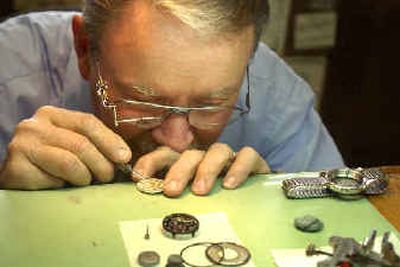Time slipping for watchmaker

For watchmakers like Larry Verhaag, time is running out.
He sits behind a glass display counter just inside the door of Halpin’s Pharmacy and Treasure Room on Sprague Avenue, a graying gentleman with an agate bolo tie around his neck and a tiny magnifying lens – a loupe – protruding from the rim of his eyeglasses.
Under a fluorescent light, he examines the pinhead-sized pieces of a half-dollar-sized machine that advances a second hand by harnessing the vibrations of a tiny tuning fork. It is a rare repair for the watchmaker because more and more timepieces are replaced rather than fixed.
“People used to rely on a watch and it became a part of them,” Verhaag said. “When you have something that serves you, you take care of it. Now they buy new ones.”
It used to be there wasn’t a jewelry business or drug store that didn’t have a watchmaker. The watchmaker’s trade organization, the American Watchmakers Institute, had 1,500 members in the Inland Northwest 24 years ago.
Then quartz watches came along and they didn’t need to be repaired as frequently as their predecessors. The change in technology was followed by a decade-long race to the bottom by companies determined to build the cheapest watch. The discount timepieces weren’t worth fixing.
By the end of the 1980s, there weren’t enough watchmakers left to justify a local AWI chapter. Verhaag, who had become the group’s chairman, secretary and treasurer, summoned all area watchmakers to Spokane for a final meeting and fancy dinner to be paid for with the dwindling group’s coffers. Only 25 people showed up, Verhaag said. They ate like kings and still had $800 left. He gave the money to the Shriners.
There are seven watchmakers listed in the Yellow Pages today. Larry’s Watch Repair isn’t among those listed, but he’s thinking about adding his number because his word-of-mouth customers are dying.
Widows of patrons have actually stopped in at the request of departed husbands to let Verhaag know a customer has passed on. A son delivered his father’s watch to Verhaag after the dad came down with Alzheimer’s and no longer needed the timepiece.
He has buckets of timepieces, some given away, some dropped off for repair and never picked up, a thousand at least. Some he gives to a church, which passes them on to the poor. Verhaag, 59, will retire in the next six years and it’s unclear who he might pass the timepieces on to.
Nationally, the ranks of watchmakers are also thinning and graying. Close to half might be ready to close shop when Verhaag does. AWI lists 60 as the average age of its members.
“There just simply aren’t that many left,” said Elanie Rolf, a horology professor at North Seattle Community College. “I think the IRS lists something like 6,000 in the entire country. There’s a fairly large need in the east.”
Rolf’s horology program is one of only 10 in the country, the only one west of Oklahoma.
In the 1970s when Verhaag became a watchmaker, there were scads of watch schools. The trade was considered a viable option for disabled war veterans. Watch repair was a skill soldiers could learn in the service.
Verhaag joined the Navy out of high school, hoping he’d be selected for fine mechanics training and the watchmaker’s title he coveted. The young sailor from Kettle Falls wound up on a tanker, instead. An officer spotted Verhaag in the captain’s store fixing a watch, the same watch Verhaag cut his teeth on at the age of 12, and asked if the sailor could fix the officer’s watch, also.
The watches turned out to be the same model and Verhaag used parts from his own timepiece to fix the officer’s. The favor got Verhaag transfer orders into a fine mechanics program, but as a typewriter repairman, not a watchmaker.
Verhaag waited until after the service and enrolled in the horology program at Spokane Falls Community College. And by chance, the watch world changed considerably. There were Accutron timepieces that relied on the vibrating energy of a tiny tuning fork. There were quartz watches that relied on the vibrations of a tiny, electrified crystal. There were the new LCD watches.
Verhaag would have missed out on the later two if his training had come earlier. Yet if he had waited longer, he would have missed out entirely, because the community college dropped its watch program two years after he graduated.
“I really have to thank God for making me wait because I learned all three,” Verhaag said. “It was good timing.”